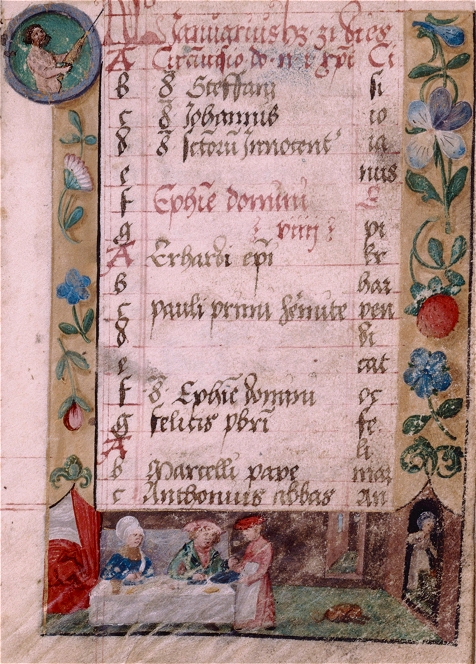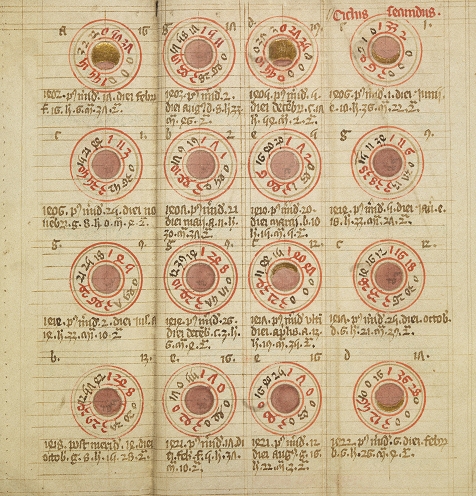- 1
- New Year's Day
Ring out the old, Ring in the new
Ring out the false, Ring in the true.
- 2
- St. Basil (329-379)
- St. Gregory of Nazianzen (329-389)
- 3
- St. Genevieve (ca. 422-512)
- 5
- St. Simeon the Stylite (390-459)
- Twelfth Night: This celebration concluded the twelve days of Christmas. The festivities opened with the choosing of a King and Queen of the Bean by serving two cakes - one to the men and one to the women. A bean, jewel or glass bead was inserted in the cakes. The man and woman who received the beans were declared King and Queen. When supper was finished, the celebrants gathered to wassail (drink a toast to) the trees. They either went outside to the oldest tree or surrounded a tree placed in the hall. Some assembled around mock trees. They toasted the tree with cider, and each cup contained three pieces of seed cake. After toasting, they ate one piece of cake, and offered the other two pieces to the tree. After this, they sang and circled the tree, then poured out the rest of their cider at the tree's roots. With this done, they shouted and made as much noise as possible. Another important part of the celebration was mumming. Plays and skits were acted out by performers, some of whom were nobles, others of whom were not. They could be traveling professionals, but usually the mummings were performed by locals. One type of mumming was the hobby horse. A highly decorated wire and straw frame surrounded a mummer who mimicked a knight astride his steed. For the final event of the night, which was performed at midnight, all the candles were doused. Suddenly a light appeared. It may have been a candle on a long pole, or a lighted chandelier that was pulled along the top of the hall by a series of pulleys. Three actors followed the light and mummed the play of the three magi. Once they defeated Herod, the festival came to an end.
- 7
- St. Raymond (1175-1275)
- 9
- St. Adrian of Canterbury (d. ca. 709)
- 10
- St. Paul (d. 342)
- Geraint: A day sacred to the ninth-century Welsh bard, Geraint, the Blue Bard of Wales.
- 11
- Plough Monday: Traditional day for returning to work in the fields after Yule. Farm workers received plough money; children received handsel (tokens) of money or sweets from neighbors.
- 12
- St. Benedict (d. 690)
- St. Distaff's Day: Named after a tool rather than an individual. Women would resume their spinning after Yule on this day.
Partly work and partly play,
Ye must on Saint Distaff's Day.
- 13
- St. Hilary (d. 368)
- 14
- St. Felix of Nola (d. 260)
- St. Kentigern (ca. 516-601)
- 15
- St. Ita (d. ca. 570)
- 16
- St. Honoratus (d. 429)
- 17
- St. Antony (251-356)
- 19
- St. Canutus (d. 1086)
- 20
- St. Fabian
- 21
- St. Agnes (d. ca. 305)
- 23
- St Paul's Day
If St. Paul's Day be fair and clear,
It do betide a happy year.
But if it chance to snow or rain,
Then will be dear all kinds of grain.
If clouds or mists do dark the sky,
Great store of birds and beasts will die.
And if the winds do fly aloft
Then wars shall vex the kingdom.
- 26
- St Eystein (d. 1168)
- St Margaret (1243-1271)
- St Alberic (d. 1109)
- St Paula (d. 404)
- 27
- St Angelia Merici (1475-1540)
- 28
- St Thomas Aquinas (1226-1274)
- 29
- St Gildas the Wise (d. ca. 576)
Photo credits: (Related Resources) (1) Opening page of calendar, elaborate border design with human figures, 1530, Digital Collections, The New York Public Library on Wikimedia Commons (2) Medieval folding almanac, ca. 15th century, Wellcome Library on Wikimedia Commons, Creative Commons CC BY 4.0

